Happy New Year! 2024 — just like that, we’re approaching the first quarter of the 21st century. And like last year, I’d like to share with you how the last 12 months have gone for WPMarmite. If you’re an entrepreneur,…
Full Site Editing is here since the WordPress 5.9 update, released on the 25th of January, 2022.
If you missed it, the goal of Full Site Editing (FSE) is to manage your website global styles and structure (header, footer, etc.) with blocks, just like the Gutenberg content editor.
As a result, we can expect really big changes in the WordPress theme market in the coming years.
At WPMarmite, we were curious about how existing theme shops consider Gutenberg and Full Site Editing.
- Are they embracing the new block paradigm? (e.g. by creating custom blocks)
- What’s their current involvement with Gutenberg?
- Are they planning to create FSE-ready themes?
To further investigate their current involvement in Gutenberg and FSE, we conducted this study. We analyzed 123 WordPress theme shops (mostly independent ones and some on ThemeForest).
Without further ado, here is the overview of our FSE study.
In November 2022, the Full Site Editing project was officially renamed Site Editor, but we will still refer to it as Full Site Editing (FSE) in this study, as this remains the most commonly used term.
Initially published in May 2021, this study was last updated in March 2023.
Here is what we learned from our Gutenberg/FSE Study
- 64% of theme shops feature their Gutenberg compatibility.
- 62% in January 2022
- 57% in May 2021
- Only 33% of theme shops offer custom Gutenberg blocks.
- 25% in January 2022
- 17% in May 2021
- 10% of theme shops provide block patterns.
- 6% in January 2022
- 3% in May 2021
- 21% of theme shops write about Gutenberg (posts about WordPress 5.0 release excluded).
- 55% of theme shops updated or released a theme in the last 3 months.
- 24% of theme shops are inactive (i.e. no update/release for at least 2 years).
64% of theme shops feature their Gutenberg compatibility
Most WordPress themes support the block editor, but not all shops feature it.
Our research has shown that 64% of theme shops feature their Gutenberg – block editor or WordPress 5.0 – compatibility on their homepage or on their theme presentation pages.
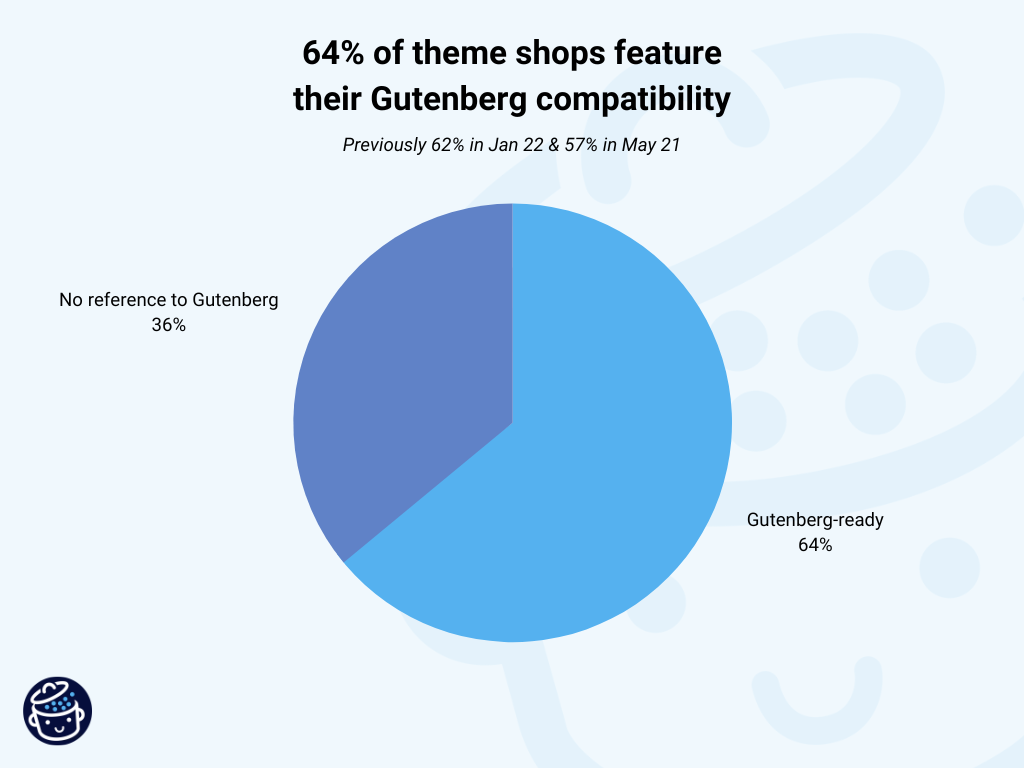
This is also the case of the Astra theme, which was one of the very first themes to be Gutenberg compatible. Others, such as Codestag, only mention “Gutenberg-ready” or “Block Editor Ready”, and WPZoom offers a whole category of block-based themes.
However, the information is not always easy to find. We sometimes had to look in their FAQ, documentation or changelog/release notes to find out (this is especially the case with MeridianThemes).
The rest of the shops (36%) don’t make any reference to show that they correctly support the block editor.
Regarding the ThemeForest themes studied (28), their compatibility is also 64%.
Only 33% of theme shops offer custom Gutenberg blocks
Out of the 123 theme shops, we found out that only 33% of them (i.e. 40) offer custom Gutenberg blocks for at least one of their themes.
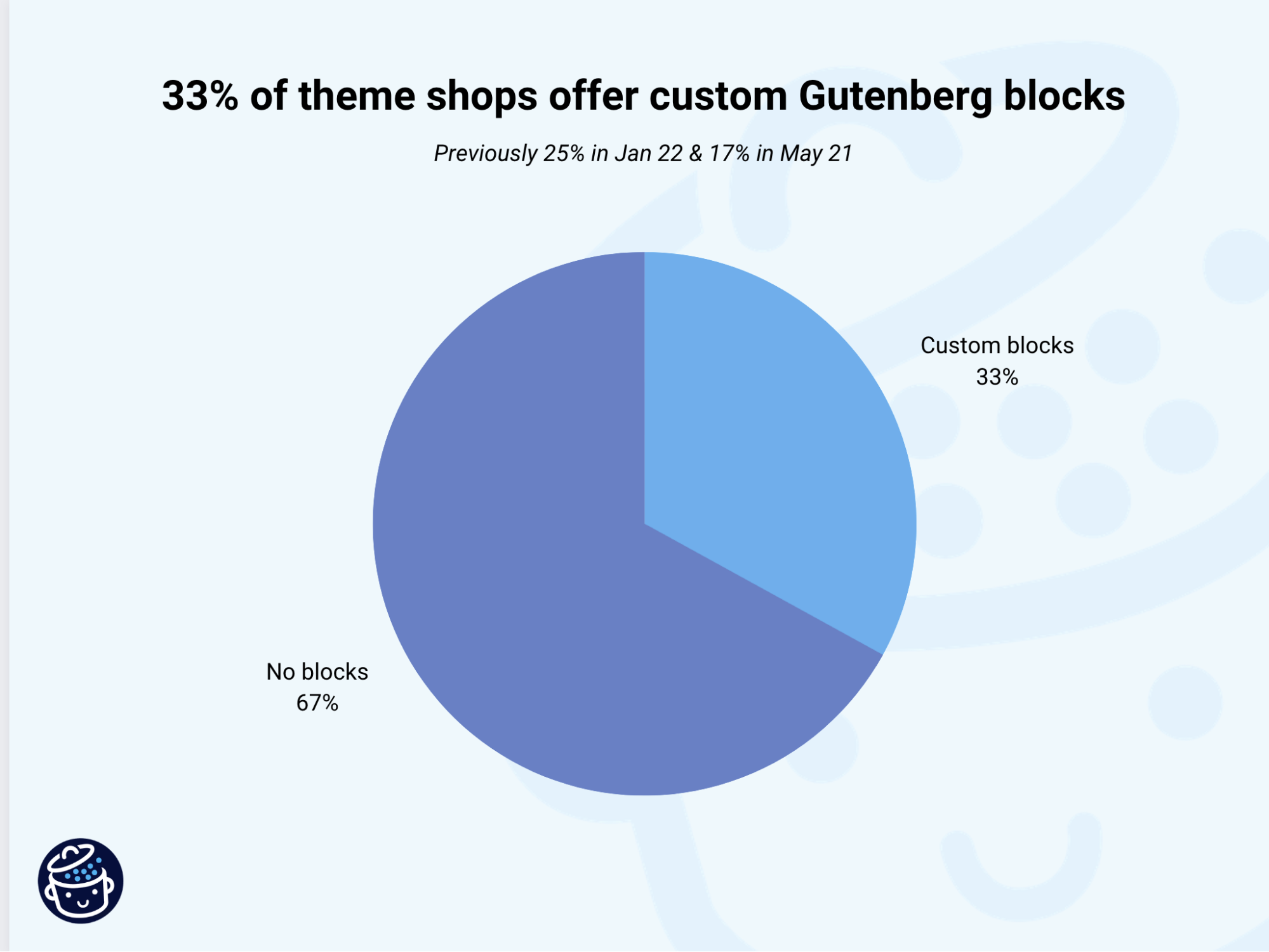
48% of the shops that created blocks didn’t add them directly to their themes but encouraged their users to install a dedicated plugin.
For example, this is the case of Pixelgrade with their Nova Blocks plugin and of CSSIgniter with GutenBee.
Others, like Atomiom from MarketPress or the last themes of ThemeZee have preferred to integrate them directly into their themes. Probably to simplify the task for their users.
Indeed, adding a complementary plugin adds a little friction when installing a theme.
However, linking these blocks to the theme doesn’t allow users to easily switch to another theme. They will be confronted with the lock-in phenomenon (known in the past with shortcodes).
10% of theme shops provide block patterns
Block patterns have been part of the WordPress core since version 5.5 (released in August 2020).
So it’s been more than two years that this feature is available to all users.
According to our Gutenberg/FSE study, only 10% of theme shops offer patterns, that is 12 out of 123.
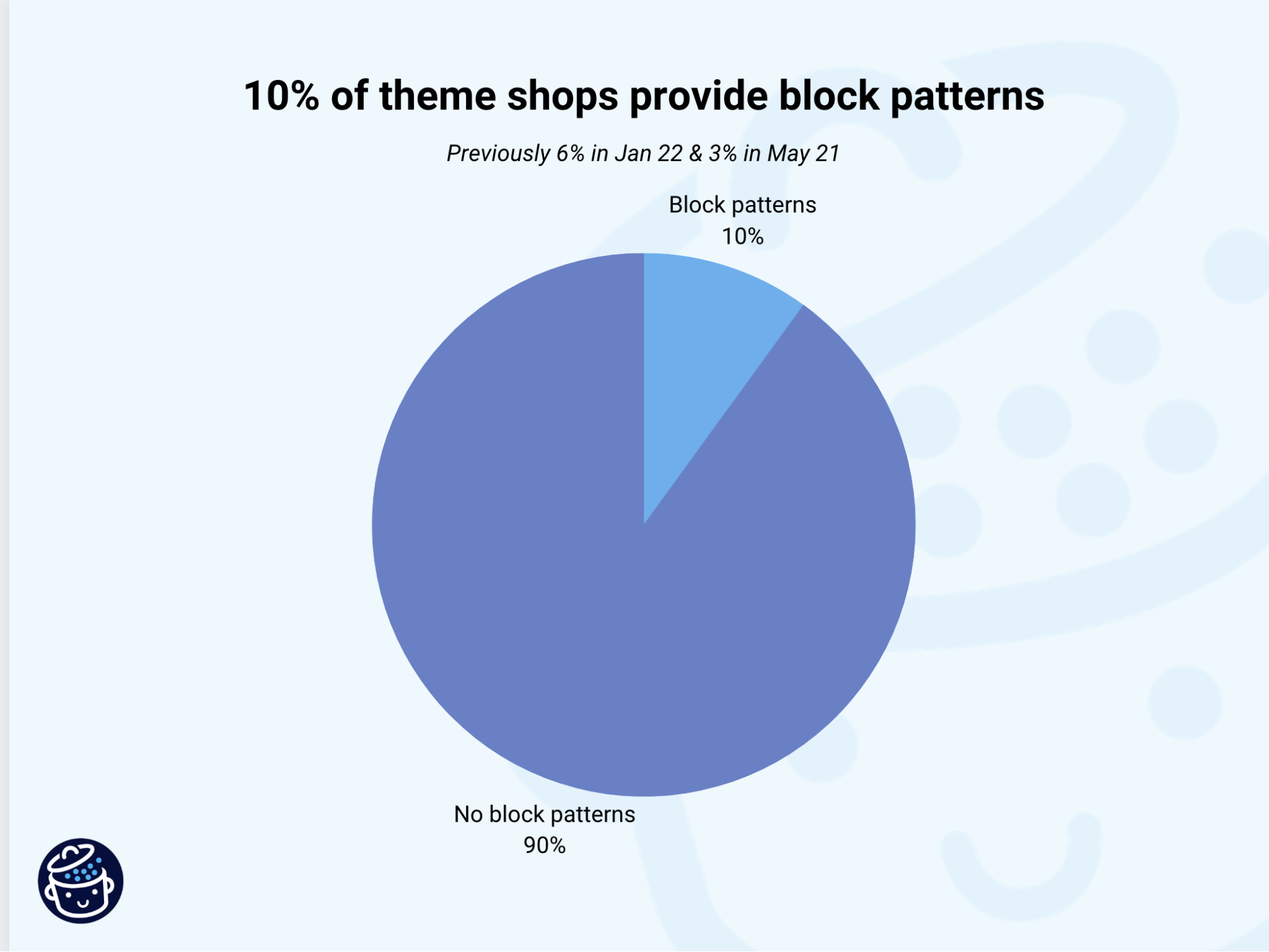
In other words, 90% don’t provide block patterns! This number drops to 86% for the 28 ThemeForest themes included in our study.
Go to ThemesKingdom, VivaThemes, Anariel Design and Anders Norén to get themes with block patterns (only their last themes have them).
Anders Norén’s themes are all free, so we can’t qualify him as a theme shop but he is a major and recognized contributor in the WordPress ecosystem. We thought it was important to include him in this FSE study.
21% of theme shops write about Gutenberg
We visited the theme shops’ blogs to see if they made their audience aware of Gutenberg with news articles and tutorials.
It turns out that 21% of them do it more or less regularly. This figure rises to 25% for independent shops (i.e. not present on a marketplace like ThemeForest).
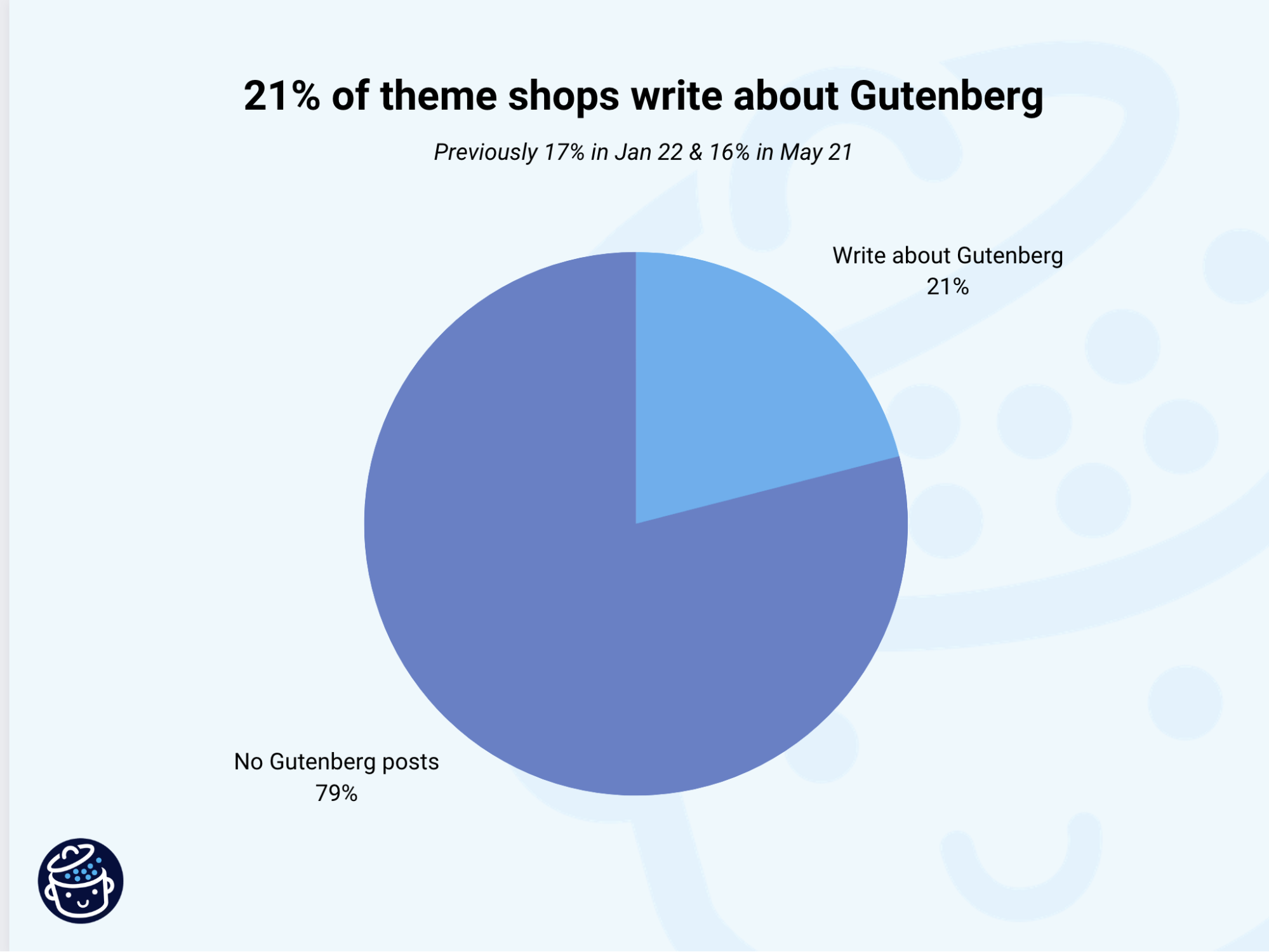
Many shops wrote an article about the new editor when WordPress 5.0 was released (in 2018) but we did not count them. The same goes for articles older than a year, in the sense that we can’t see a regular feature of Gutenberg.
As for the content, we can find two approaches:
- OrganicThemes talk about updates to their themes and plugins in terms of blocks.
- Dessign and WPExplorer publish more general articles such as tutorials and plugin comparisons.
55% of shops updated or released a theme in the last 3 months
More than half of the theme shops (55%) have at least updated or released a theme in the last 3 months.
This number rises to 59% if we look at the last 6 months.
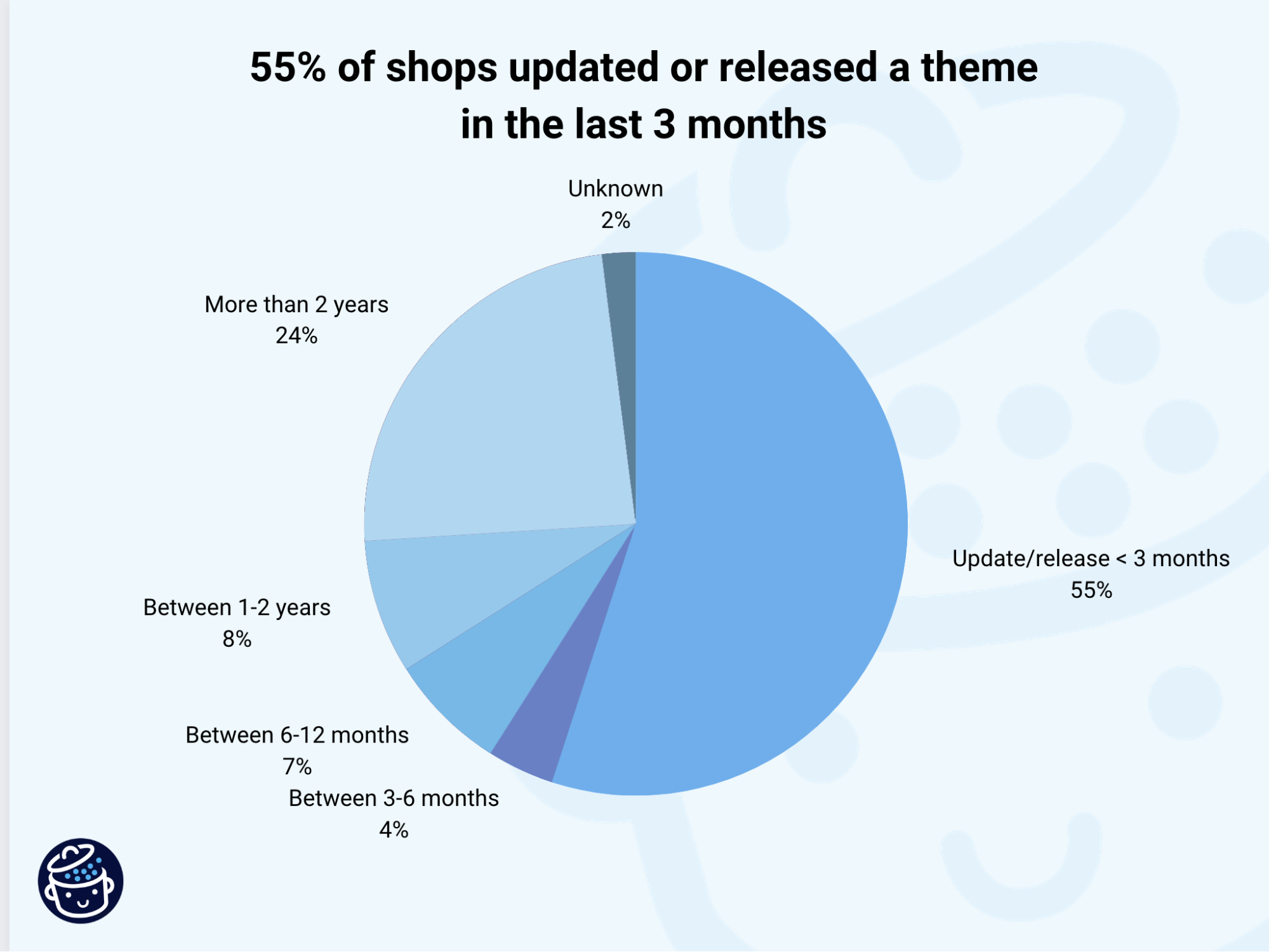
Not surprisingly, the most active shops are the most popular. Astra or GeneratePress update their products frequently to meet their users’ expectations.
However, smaller shops like Restored 316 or Viva Themes are also active.
On ThemeForest’s side, 64% of the studied themes have been updated less than 3 months ago. Since the race for features is a must on this marketplace, authors are under pressure to offer more and more to their users.
Finally, we can regret that 24% of the theme shops are inactive. By this, we mean that they haven’t made any update or launched a theme for at least 2 years.
This is for example the case with AlienWP, AudioTheme or The Theme Foundry.
Although their blog and social networks are not updated anymore, their themes are still being sold. More transparency would have been better in order not to mislead potential customers about the sustainability of the shop.
The WordPress theme market is very competitive. Becoming profitable is not an easy thing to do today, especially if you remain a generalist.
If we count the shops where we could not find information about the last theme update (like GraphPaperPress), this number rises to 26%.
86% of theme shops believed that FSE is a breakthrough for WordPress users
From this point, the following statistics are based on answers from 22 theme shops out of the 127 we’ve surveyed for the first version of our Gutenberg/FSE study, in May 2021.
They are probably not as representative of the reality, but they do provide a trend and allow keeping track of the evolution of the adoption of FSE by WordPress theme shops.
In order to dig deeper about what they think of Full Site Editing, we got more detailed insights from 22 of these theme shops.
Here are our key findings:
- 86% of these theme shops believed that Full Site Editing is a breakthrough for WordPress users.
- 82% of them were following FSE news (mostly on Make WordPress Core blog & WP Tavern).
- 22% of them were working on a FSE-ready theme.
- Only 9% of them were contributing to the development of FSE by feedback and/or code.
- 32% of theme shops surveyed weren’t working on blocks nor Full Site Editing at that time.
The majority of the shops we surveyed (19 out of 22) believed that FSE would provide more control to users.
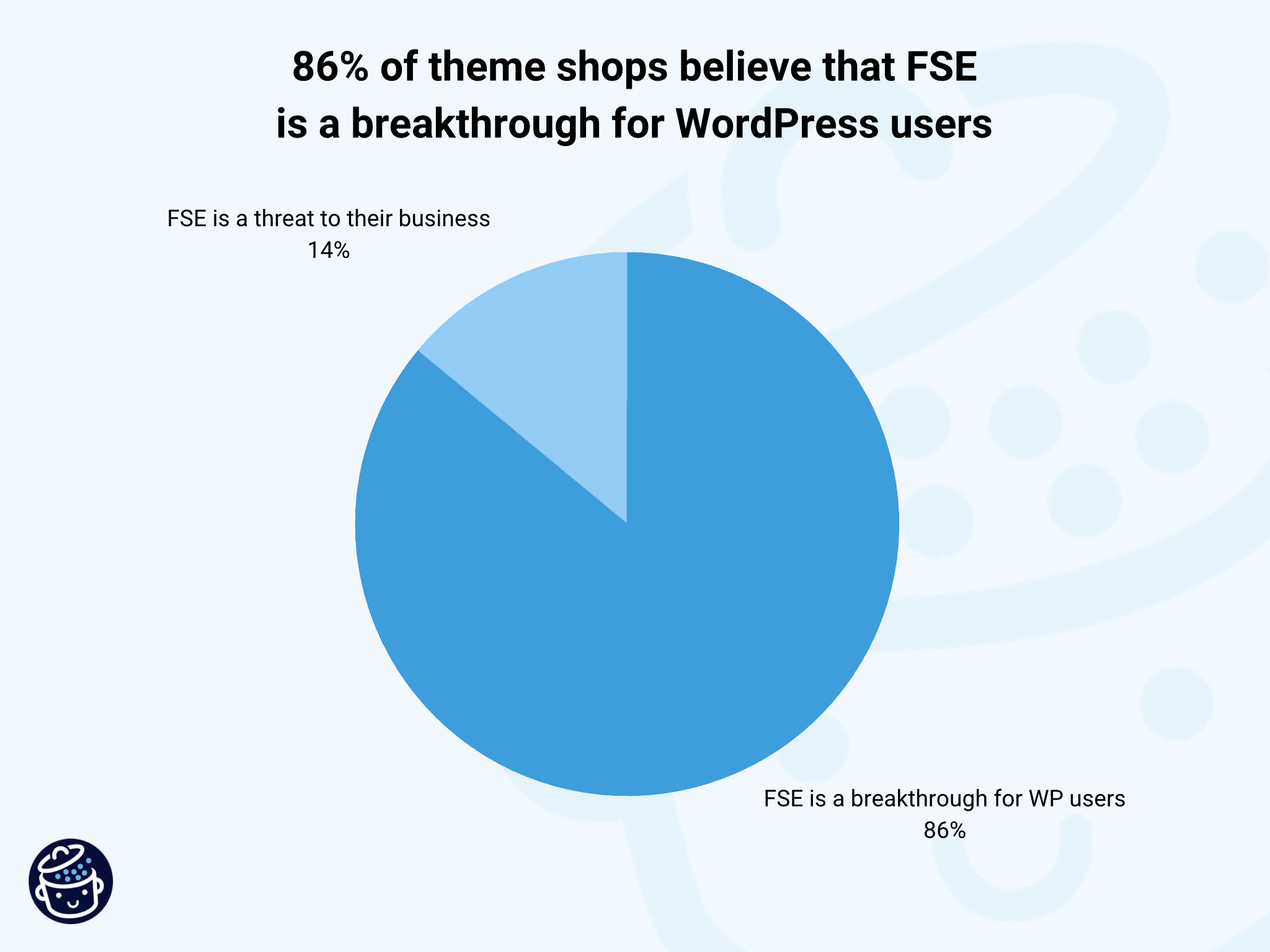
For example, Gerasimos from CSSIgniter stated that:
For the first time in the history of WordPress users will be able to edit every aspect of their website without relying on 3rd-part builders. Don’t get me wrong, there are some great WordPress page builders out there but I think it’s time for WordPress to offer its own as well.
Vlad from Pixelgrade said:
With the new block editor and FSE, the WordPress core draws a deep line in the sand: page-builders had it right all along and we will provide you with an official one so you can avoid lock-in and be fully in control. Through FSE the WordPress core assumes responsibility for something it stubbornly avoided in all these years: the site’s design. It is one thing for a page-builder plugin or multi-purpose theme to promise you that you are the designer of your site. It’s quite another for the WordPress core to openly “empower” the user with such powers. There is no going back after this.
Here is what Ramsey from OrganizedThemes believed:
This will make it easier for new customers to edit every part of their website, as long as there are enough tutorials to cover these features. We believe that this should have launched at least 10 years ago. Some other content management systems (CMS) already give the ability to edit every part of a website.
Even if 14% of them claimed that Full Site Editing was a threat to their business (3 out of 22), words from Scott, TheThemeFoundry, clarified this point:
We’re not all that worried. The writing has been on the wall for years and we’ve pivoted towards developing plugins.
From aThemes‘s Charlie point of view:
FSE is more of a threat to page builders than themes. There will still be a need for themes, even if they are block-based.
Artbees co-founder Maziar, author of JupiterX, stated:
I think just like Gutenberg was not a threat to third-party themes and page builders, this won’t be as well. But those who want to remain in the game should definitely embrace the new standard and build upon that. For example themes or page builder should be able to create layouts both with FSE and their own theme builders. Failing to add such compatibility will not have immediate consequences because this new standard will be adopted slowly (like Gutenberg) but it can be risky in the long run.
82% of WordPress theme shops were following FSE news
Are theme shops following the evolution of Full Site Editing? Our FSE study tends to prove that they were.
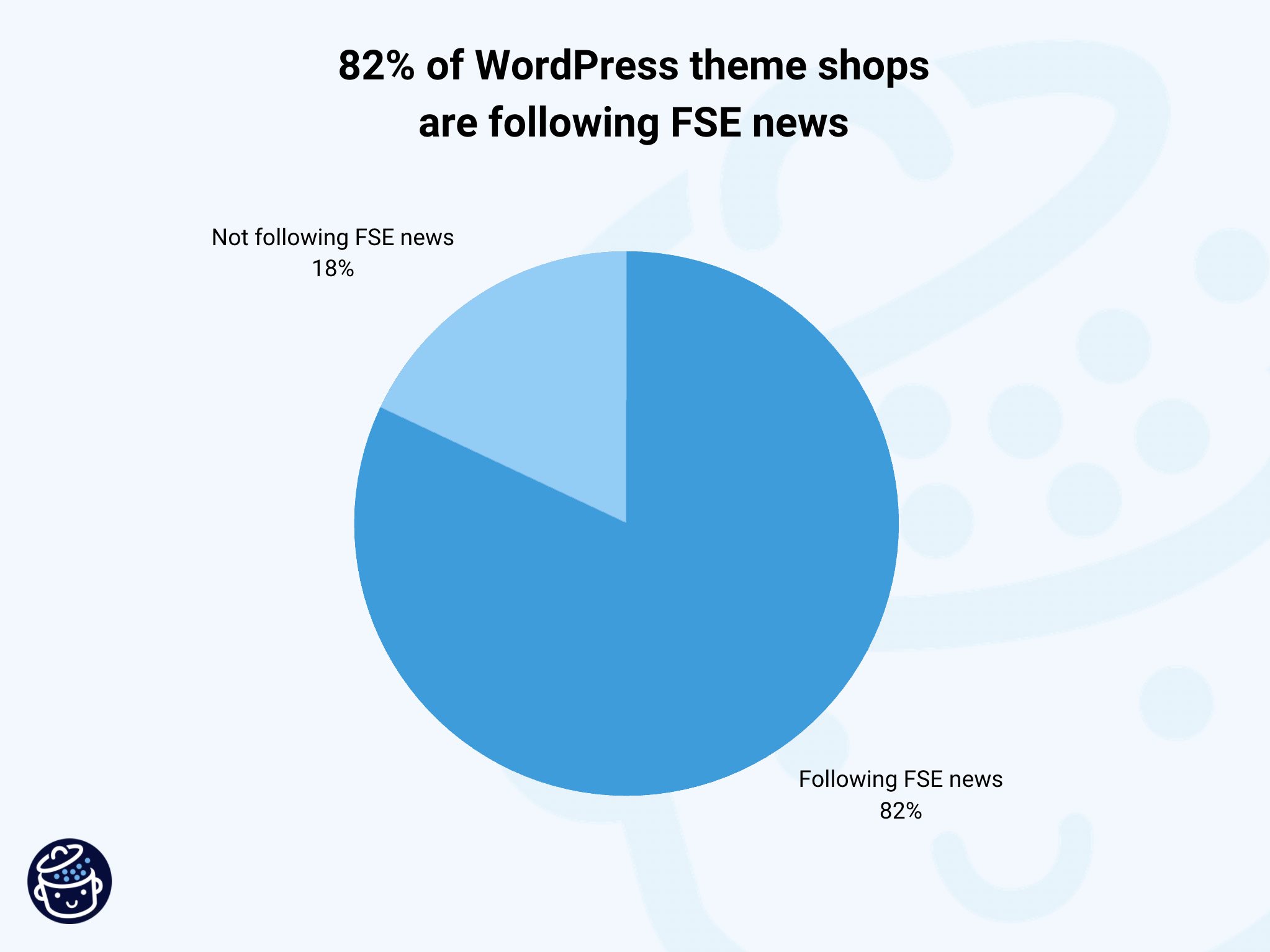
18 of the 22 shops surveyed were keeping up to date with news related to Full Site Editing, mainly on Make WordPress Core blog and WP Tavern.
You can see the breakdown below:
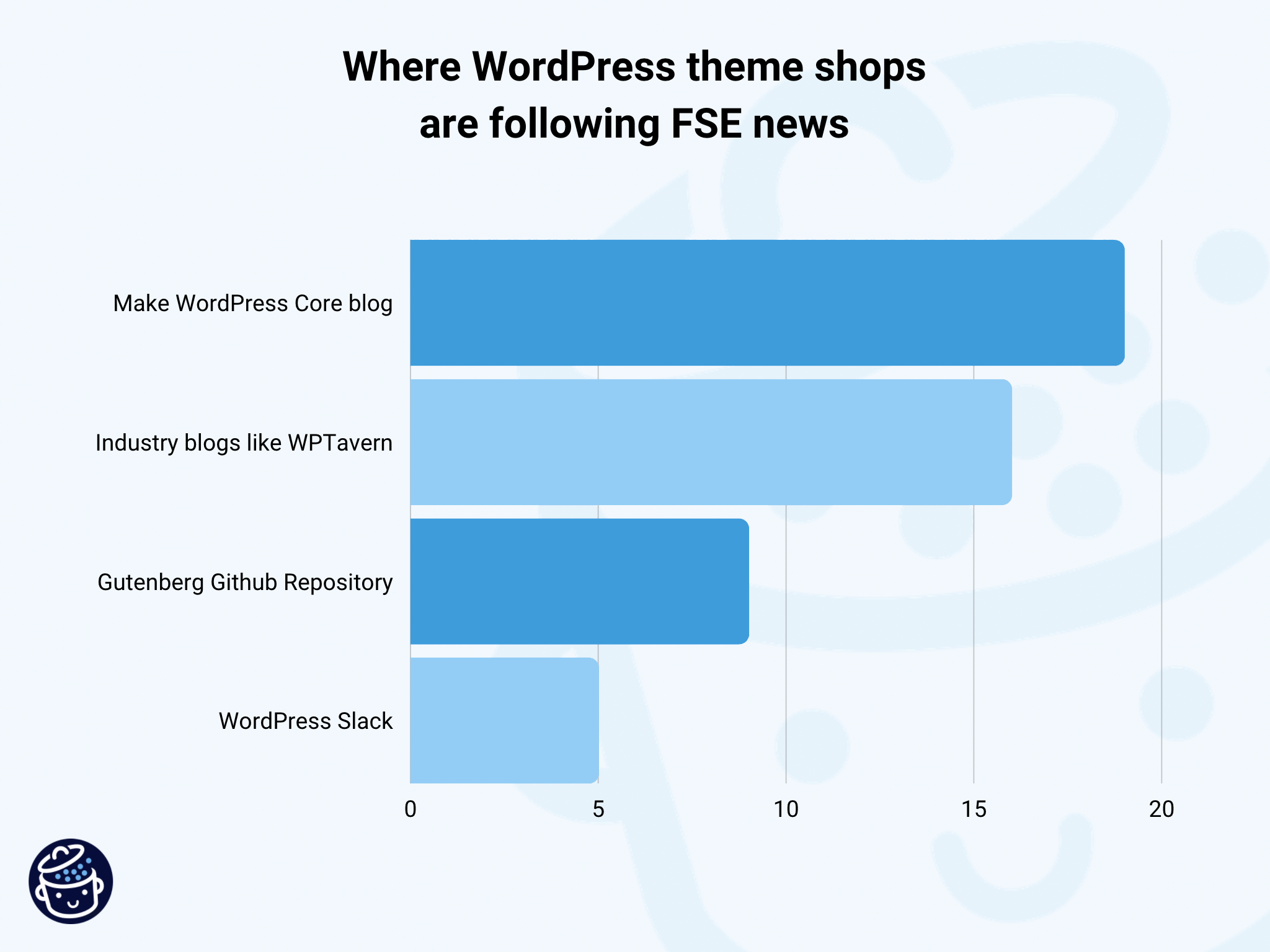
Gutenberg’s Github directory and WordPress’ Slack are a source of information two to three times less important than the previously mentioned blogs.
22% of theme shops were working on a FSE-ready theme
To date, near 250 FSE-ready WordPress themes are available on the official directory.
It is not recommended to use these themes on a production site. Their purpose is to allow you to experiment with Full Site Editing i.e. on a test site.
We discovered that 22% of the shops we’ve surveyed (5 out of 22) were currently working on a FSE-ready WordPress theme.
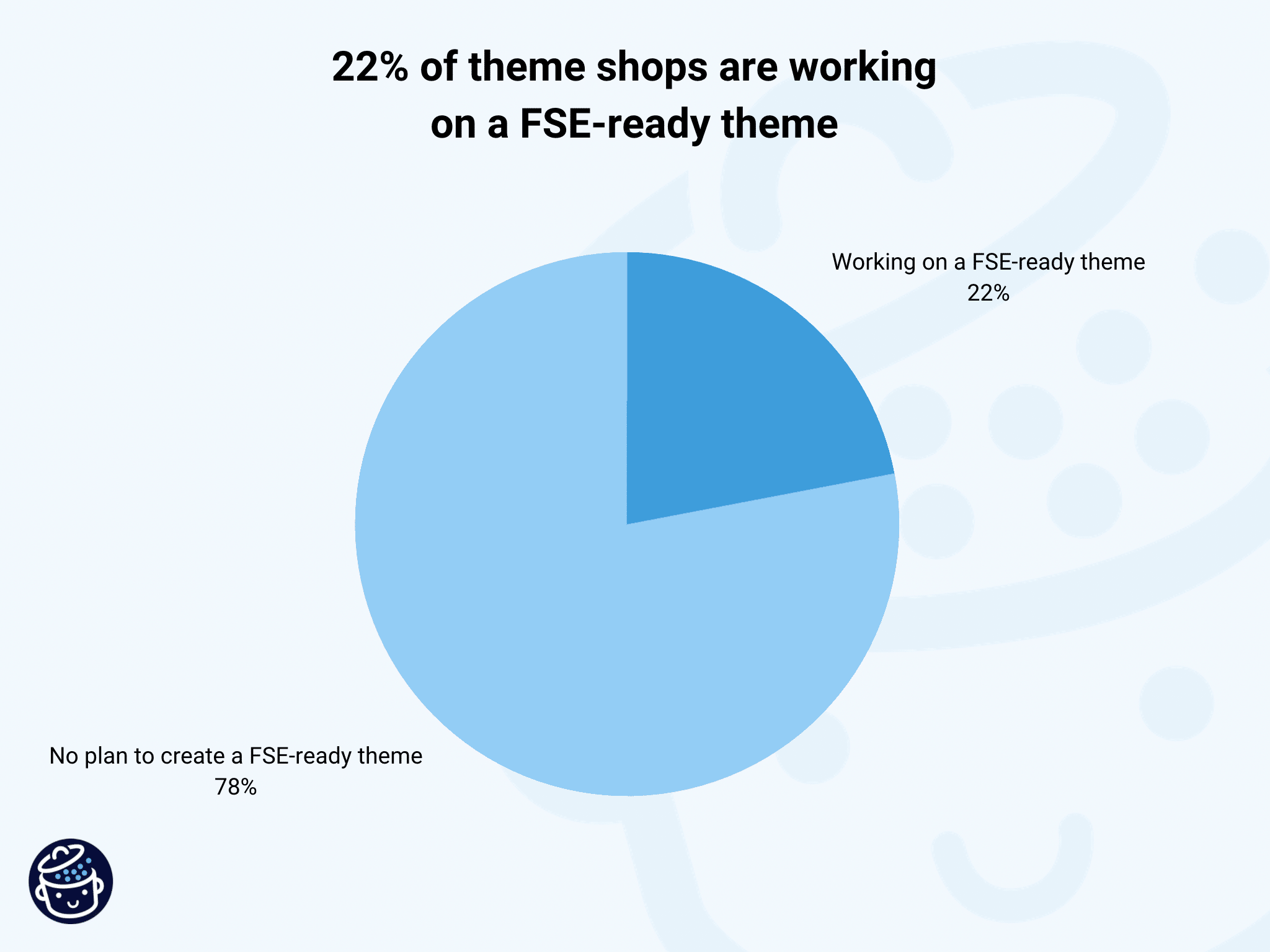
So, what are these shops?
- Pixelgrade whose team has already done a lot of work with blocks for their Rosa 2 theme.
- StudioPress with Genesis Blocks, a collection of additional blocks with 100K+ active installations.
- CSSIgniter, whose team has developed GutenBee to offer 25+ blocks (7K+ active installations).
- aThemes, editor of the Sydney theme (100K+ active installations).
- MotoPress, with Getwid, a collection of 40+ Gutenberg blocks (60K+ active installations) and 15+ themes already optimized for Gutenberg.
The remaining surveyed shops (78%) had no plans to create an FSE-ready WordPress theme at that time.
If you’re looking at creating an FSE-friendly WordPress theme, check out this course by Carolina Nymark.
Only 9% were contributing to the development of FSE
While a minority of shops were working to create an FSE-ready WordPress theme, the proportion of Full Site Editing contributors was even lower (9%, or 2 out of 22 surveyed shops).
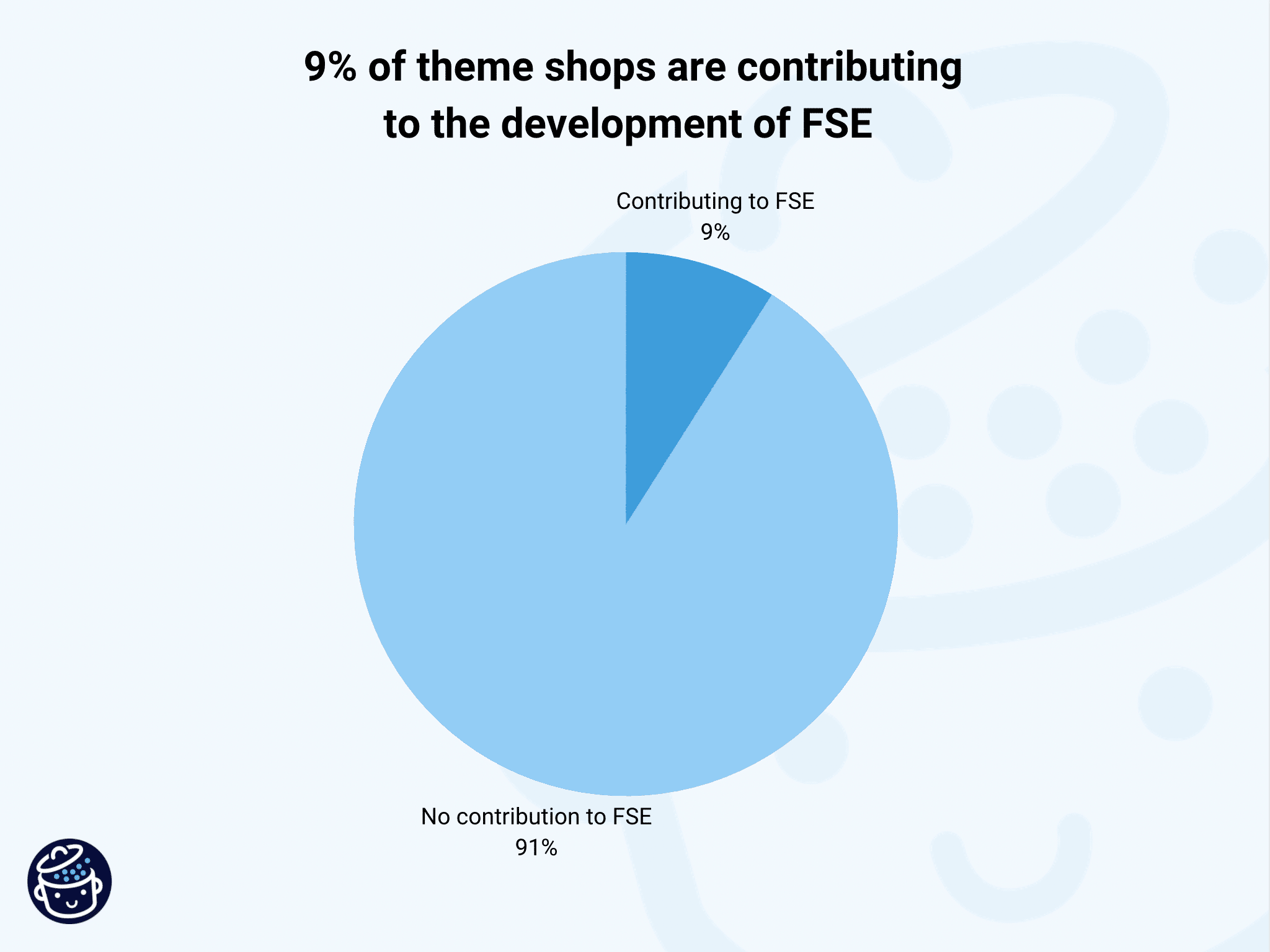
The most common form of contribution was to provide feedback on the work done by contributors, especially by responding to the FSE outreach program.
Not every shop can afford to contribute regularly. Shops with large resources are more likely to contribute to the development of FSE and WordPress more broadly.
Big shout out to StudioPress and Astra for their contribution to FSE!
32% of theme shops were not working on blocks nor FSE at that time
32% of the shops we’ve surveyed (7 out of 22) stated they were not yet working on Gutenberg blocks nor FSE.
This proportion will probably decrease in the coming months and years. We can imagine that the integration of FSE in the WordPress core will push other shops to take the plunge.
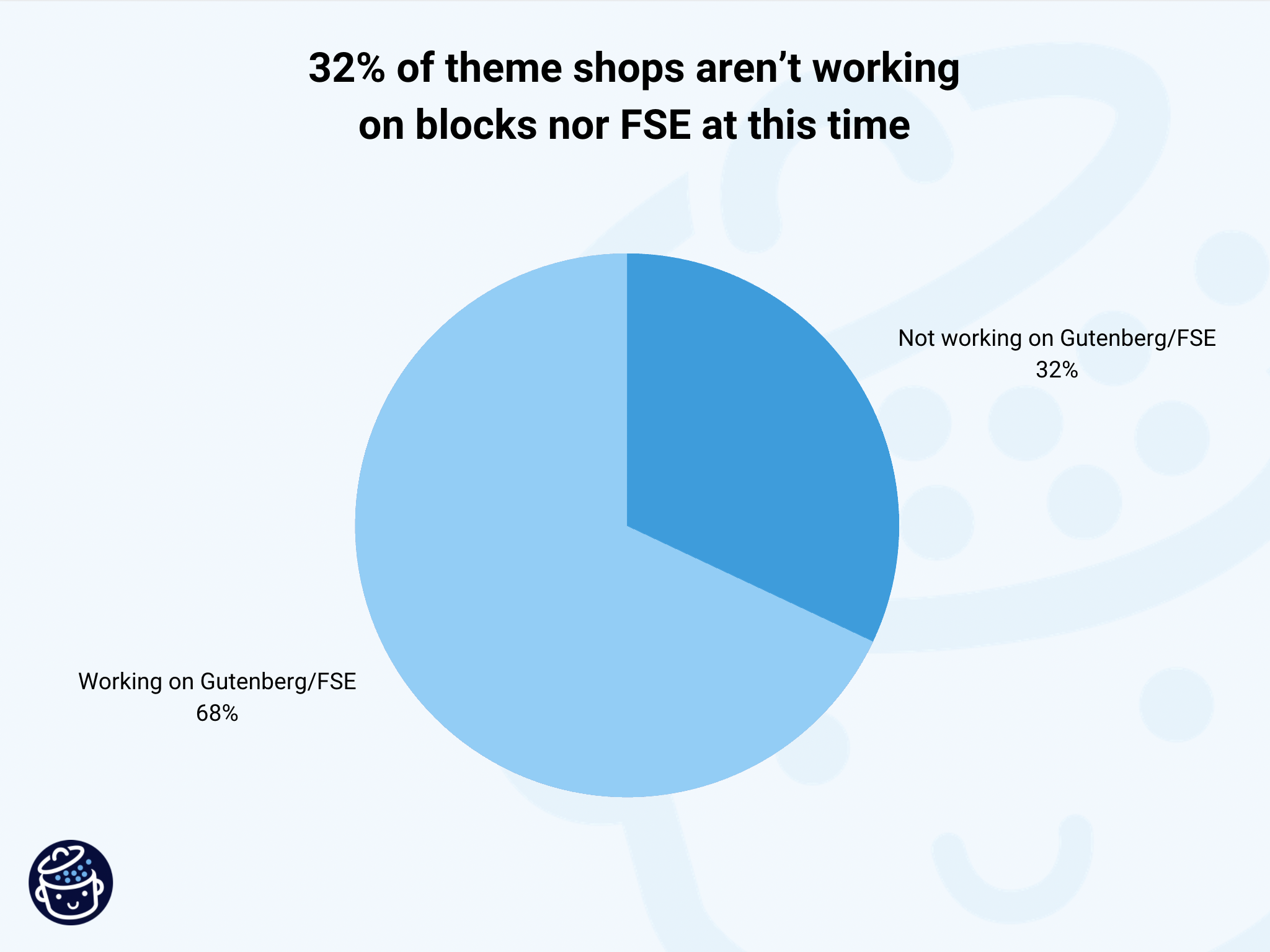
However, this means that 68% of the shops had already started experimenting with Gutenberg (also by creating their first blocks).
As with the contribution, there may not be enough resources in the shops to take on such a project at this time.
Conclusion of our Gutenberg/FSE study
67% of them do not offer Gutenberg blocks and 90% do not offer block patterns.
For the moment, there is no reason to believe that they will massively adapt to FSE.
However, most of them see FSE as a breakthrough and are keeping abreast of its evolution.
The most popular theme shops are preparing for it. Their goal is to give users the freedom to completely design the appearance of their site with their themes.
As Anders Norén said in this article:
Full Site Editing will be a big change for WordPress themes, and for the role they play in the larger WordPress ecosystem.
Will new FSE-ready theme shops emerge by the end of 2023? We can’t know yet, but one thing is for sure: Full Site Editing is going to offer a lot of opportunities in the WordPress theme market in the years to come.
Anders Norén and Brian Gardner (from WPEngine) are leading this movement. You can check the Tove and Frost themes to get started.
If you want to learn how to develop your first block based theme, we recommend you to take the training of Fränk Klein (“full stack engineer specialised in planning and delivering WordPress at enterprise scale” at Human Made).
Thank you for reading this article to the end. We hope you enjoyed browsing through our Gutenberg/FSE study!
You can find the the raw data and our methodology in this file. If you work in a theme shop and would like to share your feedback on Full Site Editing, click here.
Now we’d like to know what you thought about it. What number stood out to you the most? What do you think about the arrival of Full Site Editing?
Tell us all about it in the comments.

Receive the next posts for free and access exclusive resources. More than 20,000 people have done it, why not you?








And what about the WP existing themes? (as Twenty seventeen…)
Are they FSE-compatible?
Hello, they will probably be all compatible in a near future.
Hi,
What about the previous WP themes compatibility?
Regards,
Michel.
Every themes will be update soon we hope 😉